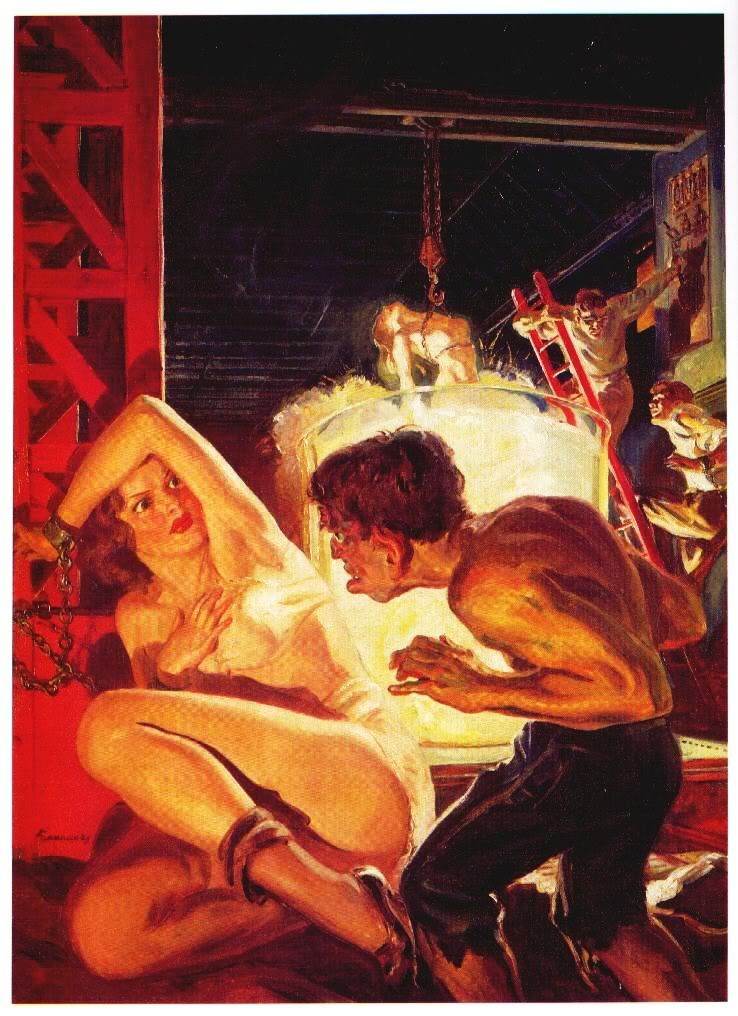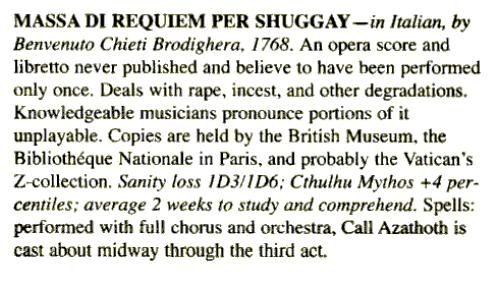Having had the chance to savour Basterds at length, the time has come to revise and expand on my initial blog about the glorious uniform porn the film provides. For a movie which changes history, it does a great job of re-creating aspects of WW2 better than many of its peers. The original blog still stands, but this one will add some of the more obscure details, and look at some of those awesome, Tarantino-type tidbits that pander to us trivia freaks!
The Basterds And Their Patches
The eight men in the Basterds have clearly been handpicked, Dirty Dozen-style, from a number of outfits. I guess Raine just combed the files looking for eight Jewish-American soldiers with a knack for killing; or they could have "volunteered" one way or another.
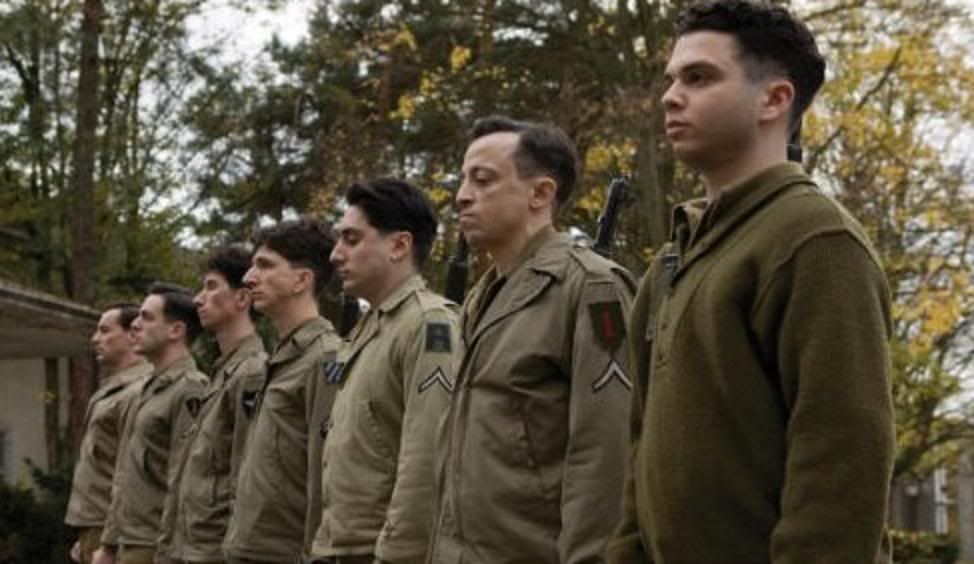
Every American serviceperson wore some kind of insignia on their left sleeve, which represented their unit. We can get a rough idea of each Basterd from their divisional patch.
Starting with the closest, and moving back:
PFC Gerold Hirschberg - well, he's actually wearing a service jumper instead of a jacket, so we'll never know his outfit!
PFC Michael Zimmerman - proudly bears the giant patch of the 'Big Red One', the 1st US Infantry Division. This was the first American division in action in Europe, and logged more time in combat than any other US infantry unit. Zimmerman is one of the three Basterds who disappear after the second chapter.
PFC Omar Ulmer - who will later go down blazing in the theatre, isn't actually wearing a division patch. His badge is 1st Army, meaning he served in some capacity on the Army's headquarters staff. He could have been anything like a driver, a cook, or a clerk.
PFC Andy Kagan - the second mystery Basterd. Kagan's patch is of the 3rd US Infantry Division, the 'Rock of the Marne', mainly famed in WW2 for being Audie Murphy's outfit.
PFC Simon Sakowitz - the third mystery Basterd. He wears the large and distinctive 'Indianhead' patch of the 2nd US Infantry Division.
PFC Smithson Utivich - the only Basterd that we know is alive at the end. His patch is indistinct, and is giving me frigging headaches. It looks like some kind of Airborne badge, but it also could be a headquarters-type one like Ulmer.
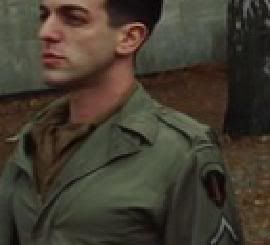
I seriously can't make it out; and given how arcane this kind of insignia can be, I have to give up.
Cpl. Wilhelm Wicki - last in the line, this guy's badge can't been seen here, but is obvious in another shot. It's the blue-and-gold lozenge of the Rangers, probably the 5th Battalion. It makes sense that this elite commando unit would recruit a native-born German, and suggests he too had been in action for some time.
And of course : Sgt. Donnie "the Bear Jew" Donowitz - Aldo's number two, and the most fearsome of the Basterds. Out-of-shot in this photo, but earlier in the scene we see he has a 'Blue and Gray', or 29th US Infantry Division, patch. This outfit played a major role on D-Day, and suffered heavily.
A Few Weird Things About Landa
Several things about Landa's medals are wrong, although absolutely no-one except a fetishist would notice. There is some solid continuity; when we first meet him in 1941, he is wearing neither his Anti-Partisan or Proficiency Badges, which were not yet instituted. On the other hand, he is wearing the Eastern Front, or so-called "Frozen Meat", medal - awarded for service in the Russian winter..of 1941-42. It's most remarkable he got one six months before they were actually awarded!
< While we're on the subject, the SS Proficiency Badge is a bit of an issue.

Technically this award was never given to actual Germans, but rather to the many European volunteers who joined the SS. It symbolised that they were "honorary" Germans, but not "proper" SS. Landa is an Austrian cop, but after researching the subject further, I'm very doubtful he would have qualified for this. I'm putting its inclusion in his medals down to 'rule of cool'.
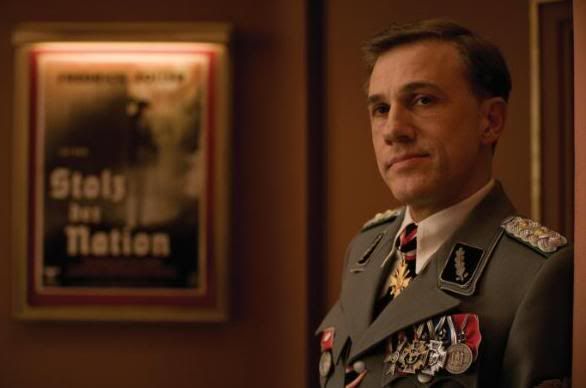
On the Big Night, Landa pulls a few more medal shenanigans. The Gold War Merit Cross with Swords around his neck would not be developed until the end of the war, and none were ever actually awarded! The Frozen Meat medal is there, although now at least he could claim some qualification for it. But most intriguingly, he has a couple of very old Austro-Hungarian medals in that rack, which he is far too young to have earned. I don't think the Reichsfuhrer would have been impressed with such examples of "stolen valour"!
As an aside to Landa, his driver (and possible boyfriend?) is worth a word.
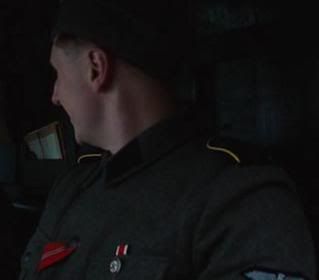
The unfortunate Hermann is an SS-Mann (Private) of the SS 3rd Division, "Totenkopf" - a notorious outfit. He wears the yellow piping and badges of a signalman or radio operator. He also has the Eastern Front Medal and an ornamental Nazi Party pin.
The SS Disguises
When they attend their fateful meeting in the basement of La Louisiane, Hicox, Stiglitz and Wicki are all disguised as officers of the Waffen-SS. The three paint a very convincing picture of a group of elite, hardened veterans:
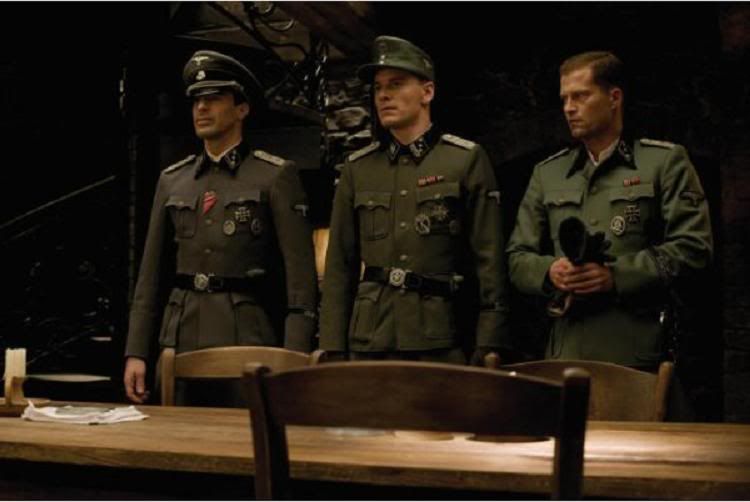
Wicki (at left) is an SS-Obersturmfuhrer (Lieutenant 1st Class) of the 2nd SS Division, "Das Reich". He bears the Iron Crosses 1st and 2nd class, the Eastern Front Medal, a Wound Badge (in Silver, meaning twice) and a General Assault Badge.
Hicox (center) is an SS-Haupsturmfuhrer (Captain), also of "Das Reich". He only has a War Merit Cross (no Iron ones) but also bears an Assault and Wound Badge.
Lastly, Stiglitz (at right) is another SS-Obersturmfuhrer, this time of the infamous 12th SS Division, "Hitlerjugend". The fact that this serious Nazi-hater is masquerading as an officer in one of the most fanatically Nazi divisions, is grimly humorous. He's a mess - uniform unbuttoned, hatless, and missing a couple of medals! But then, that's Stiglitz!
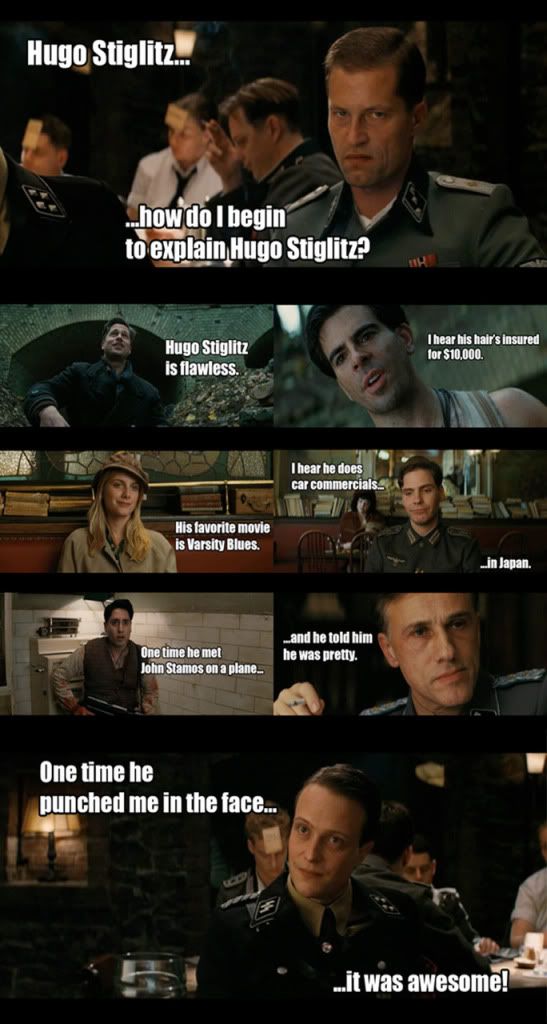
SS-Sturmbannfuhrer Dieter Hellstrom of the Gestapo
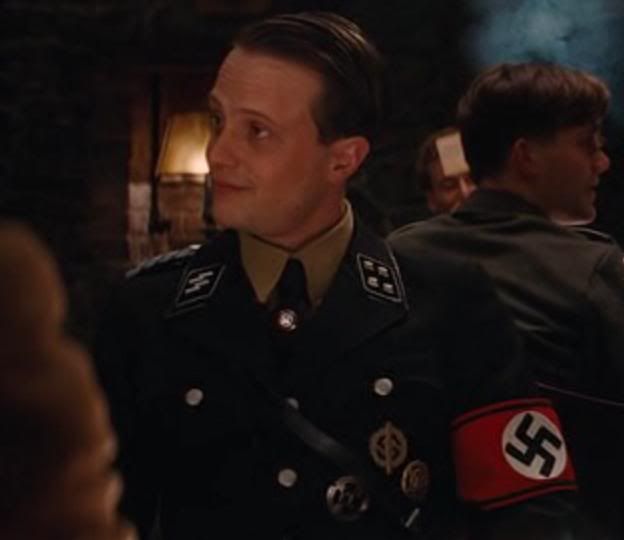
This fellow is the very image of the Hollywood Nazi. The black uniform with brown shirt and swastika armband became a filmic cliche of Gestapo tyranny long ago. And like a lot of his cinematic forbears, Hellstrom, as a Gestapo Major, should not have been wearing this. By 1944, the black uniform was seen as a "shirker's outfit", something only the clerks and desk jockeys of the Allgemeine-SS wore. Everyone else had gone over to field gray, whether they actually served in the field or not. Or in the case of Gestapo officers, they adopted the equally classic long black coat and fedora - the Herr Flick look.
So although it's utterly inaccurate, Hellstrom's uniform performs the job of screaming GESTAPO GOON well enough. I am kind of surprised that Tarantino didn't go for the more disturbing, parodic Flick type, however. (And how about the name? I, of course, couldn't help thinking of Patsy Walker's second husband, but that's just me).
His medals are, as ever, revealing. Once again we see the Proficiency Badge on a guy who shouldn't technically be wearing one (or at least, would wear it only while in civilian garb). The other two medals are obscure Party ones, awarded for attendance at one of the pre-war rallies, or the like. I believe the middle one is a long-service badge. It is interesting to note that Hellstrom is quite young to be a Major, in contrast to his older yet junior-ranking Allied counterparts. He's a guy who's enjoying his thuggery - the way he grins like a power-tripping creep after bringing Shoshanna to see Goebbels, reveling in her fear - so he naturally must have risen fast in the Gestapo. Sadly, there were a lot of Hellstroms in reality.
The Greyshirts of La Louisiane

The merry assemblage of Wehrmacht personnel who all get wasted in the basement are pretty unremarkable. The boys appear to be regular infantry, one with a standard Assault Badge. Just regular dudes having a few brewskis. Their female colleague is an interesting inclusion; those women who served in the Wehrmacht have had very little on-screen representation. Her jacket is nowhere to be seen, but it's safe to assume she's a Blitzmadel, not unlike Helga (seeing as we're on the Allo Allo references).
Feldwebel Werner Rachtman
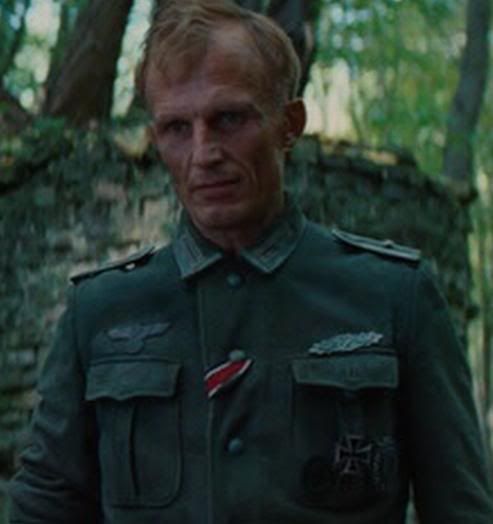
When Donowitz taunts this weary veteran about his medals, Rachtman's steady reply is one of the best moments of the movie. His courage in the face of a very grisly death is borne out by his decorations. He's a classic Alte Mann, an old-school Feldwebel (Sergeant) who could have made Field Marshal years ago, but had instead remained utterly loyal to the guys at the Front. He has both classes of Iron Cross, a Bronze Wound and Assault Badge, and most notably of all, the Close Combat Clasp (in Silver) above his breast pocket.

Among real soldiers in the Reich, this Clasp was often more highly esteemed than the Knight's Cross. It showed that the bearer had been in the hardest fighting, non-stop, for longer than any soldier should have to endure. It was rarely awarded, so for a regular Army sergeant to get one is definitely noteworthy.
Nazi Girl Scouts
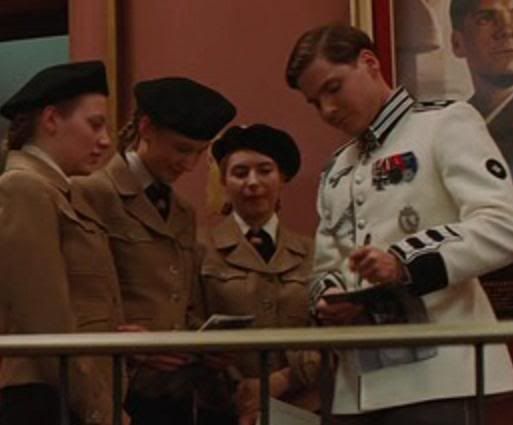

Everybody seems to know about the Hitler Youth (Hitlerjugend) but not many people realise it had a girl's branch, the League of German Maidens (Bund Deutscher Mädel, or BDM). The appearance of three BDM girls at the Big Night - probably as a reward for their cookie sales - jumped right out at me. The whole Big Night scene is uniform trivia madness; but these three made an interesting addition. Of course, they all die horribly with the rest in the theater, but ah...well...they were Nazis, right? I suspect they were included here on purpose, as part of IB's very complicated look at just what the Nazis were. Among the mediocre Party creeps in their fecal brown outfits, and Dicke Hermann in his outrageous uniform, there were three bobbysoxer girls who were waving the swastika too.
A Few Weird Things About Zoller
For one of the Reich's top soldiers, this guy seems to have a very poor grasp of uniform and medal protocol. He does get to show off the 'experimental' uniform some soldiers of the Grossdeutschland Division got to wear; if you compare it to regular German Army uniforms like the ones above, you can note its rather weird modernity.
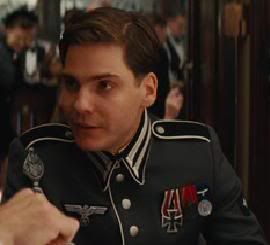
At his lunch with Goebbels and Shoshanna, things seem above board. He has the Marksman's Aiguillette, as you'd expect for a master sniper. The Iron Cross 2nd Class and Assault Badge are standard infantry, with that ever-present Eastern Front Medal also in evidence. But anyone familiar with decorations of the Reich would ask : where's the Knight's Cross? He would most certainly have one, yet he doesn't even have the Cross in 1st Class. Dude certainly seems to have been shortchanged on his medals. Yet, later...
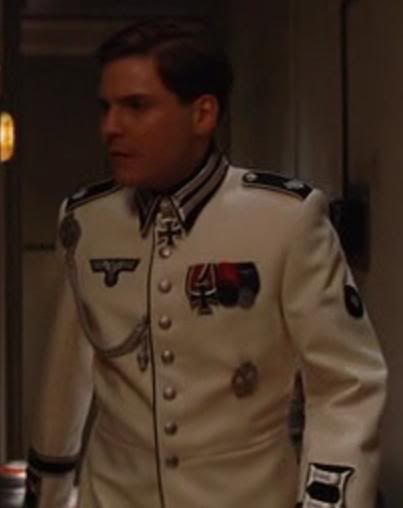
Heigh-ho! A Knight's Cross - complete with all the trimmings - has suddenly appeared. Yet still no Iron Cross 1st Class, without which he never who have got his Knight's. Believe me, its absence is really obvious.
That's all for now. Your local library can certainly help; there's no end of books on the subject of WW2 uniforms. Also, check out IMDB's trivia page on the flick for a few more details - like how Hicox wears his beret French-style, and so forth. Hope you find what you're looking for!
